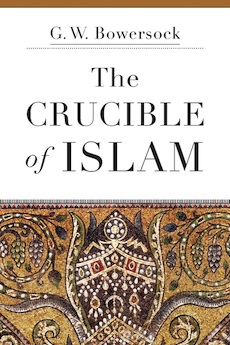By LaiYee Leong
What explains the ascent of a small migrant fellowship of believers in a land where Judaism, Christianity, and many pagan cults had long endured? To what extent did being on a peninsula between two great empires in conflict contribute to the Prophet Muhammad’s success in spreading his message? In his latest book, G.W. Bowersock (ΦBK, Harvard University, 1956), Professor Emeritus of Ancient History at Princeton, considers this line of questioning. Demonstrating a mastery of historical methods honed by a lifetime’s work, Bowersock skillfully assesses established and new evidence to illuminate the larger cultural landscape from which Islam developed.
Numerous books by academics and non-academics alike have presented the narrative of the rise of Islam. Bowersock’s treatise is not one of them; rather, it goes outside the chronicle of Muhammad and his followers to frame it within its setting. The Crucible of Islam focuses on the “chaotic environment” of 6th and 7th century Arabia that gave shape to a new monotheistic faith. Bowersock turns the spotlight on the tumultuous milieu that made possible the success of the Prophet and the subsequent emergence of empire. This less-explored perspective offers intriguing new insights, as Bowersock provides an account that richly situates Islam’s origins in context. The reader is assumed to have a basic familiarity with the biography of God’s Messenger and the dramatic events of Islam’s first century. Most of the volume focuses on the periods bookending 610 to 632 AD, before and after Muhammad communicated his revelations and built a community of followers.
This book is necessary, and under Bowersock’s execution, valuable. Fervent interest in Islam continues, especially in its past. As I can attest from teaching undergraduates and making public presentations about the intersection of Islam and politics, many people seem to believe the circumstances of Islam’s founding and its early experiences define the religion today in a way that is not assumed of other faiths. I frequently find myself fielding questions about the history of Arabia even though I am a political scientist concerned with modern states and international relations. Whatever one’s views as to whether the Islam of 1400 years ago could elucidate contemporary politics, The Crucible of Islam vividly adds to our understanding of how religion and politics might interact in explosive and consequential ways.
The first half of the text concerns the few decades preceding the Prophet’s appearance. Bowersock lays out in sharp detail the geopolitical significance of the intense rivalry consuming the Byzantine and Sassanian empires on either side of Arabia. He outlines the shifting alliances and enmities running through the peninsula, with its kingdoms and tribes. Also depicted are the complex religious currents swirling throughout Arab society, which was the product of Jewish, Christian, and Arab pagan influences. Such conditions both fostered and constrained the development of Islam. One gets a clear sense of the challenges that the first Muslims encountered and why they were so quickly beset by civil wars. An appreciation of the sociopolitical environment also helps unravel the mystery of a foundational episode in Islamic history, one that believers see as testament to the Prophet’s blessed status but which has baffled historians—Muhammad’s remarkable accomplishment in forging the Medina Constitution. In this instance, Bowersock deftly joins his deeper contextualization of the Islamic narrative with new research by another scholar to offer a convincing original hypothesis.
The second half deals with the broader social impact of the Caliphate after Muhammad’s death. Again, by looking beyond the conventional narrative and the official triumphalist descriptions that arose with the growth of Muslim political power, Bowersock suggests Islam’s early institutions were in greater flux than assumed. He disputes the administrative authority of the first four Caliphs, despite their idealization in religious accounts, and the extent to which Islam changed daily life even as these leaders expanded their reach over vast territories. Bowersock’s postulation tempers the accepted view that Islamic religious and political development happened rapidly and violently. It took a later caliph from the Ummayad dynasty in Damascus, seeking to put down a pretender in Mecca, to consolidate the empire with institution building. A central part of this undertaking involved the building of the Dome of the Rock, an edifice that now stands at the religious and political heart of Jerusalem and all three monotheistic religions.
This connection to one of today’s hotspots—the center of so much turmoil in the Middle East—leaves no doubt that the region remains a terrain that is intensely contested and volatile. Historical context surely matters in any effort to understand that part of the world; Bowersock’s learned exposition of the crucible from which Islam emerged adds another important facet to our collective knowledge.
LaiYee Leong (ΦBK, Yale University, 1994) is a Fellow at the Center for Presidential History and a Fellow at the John G. Tower Center for Political Studies at Southern Methodist University.




